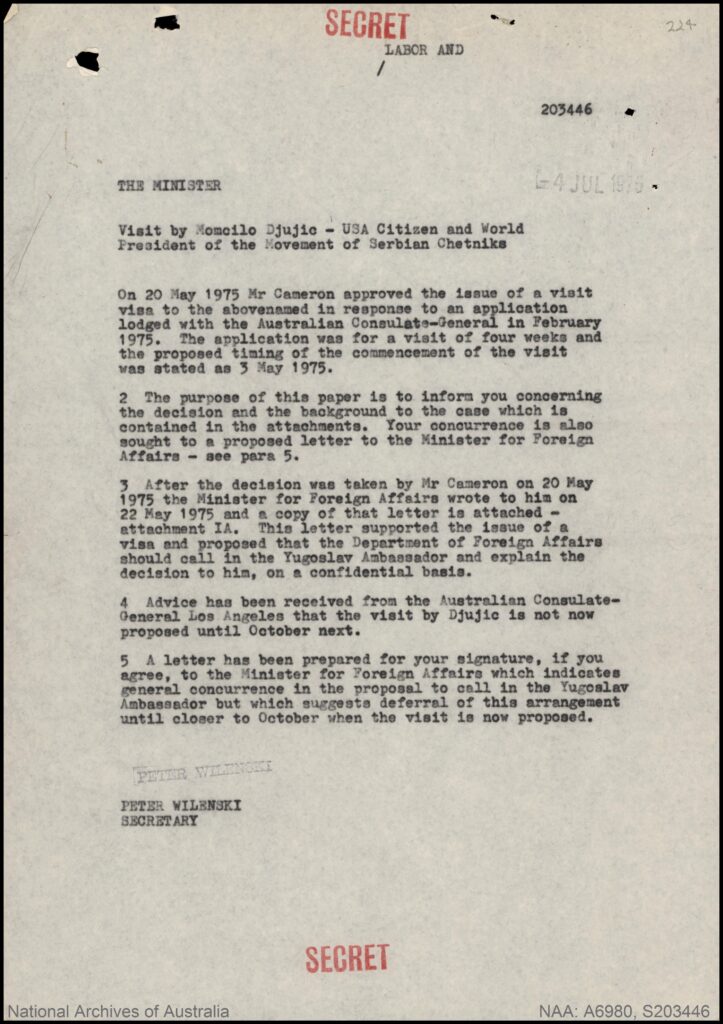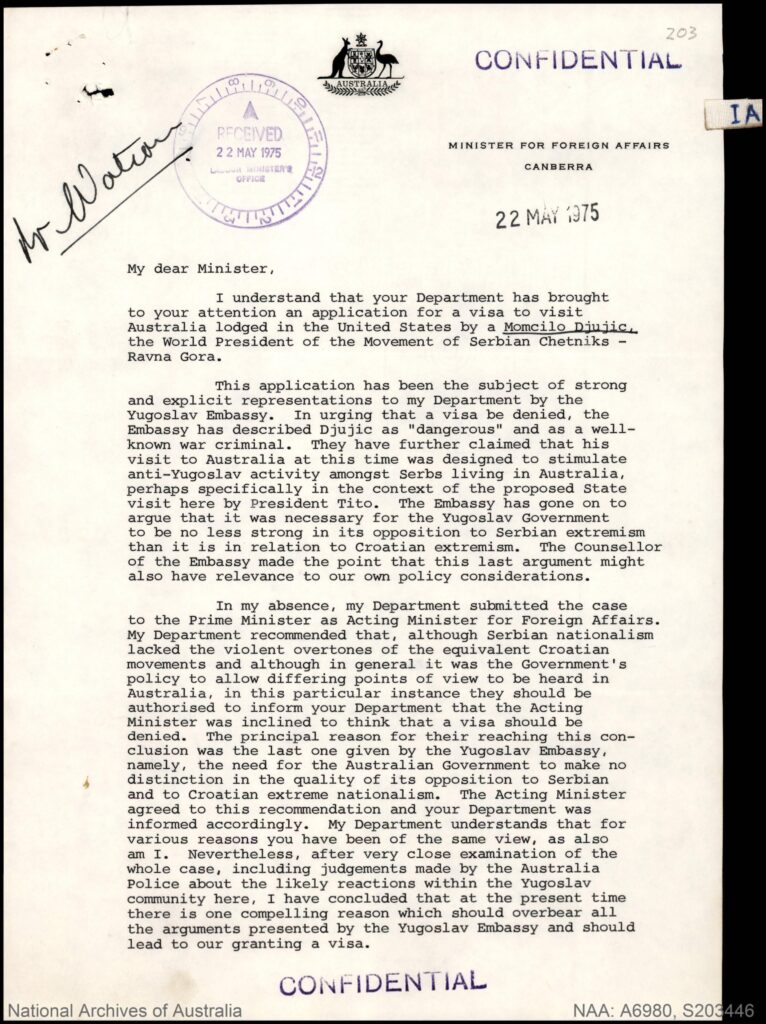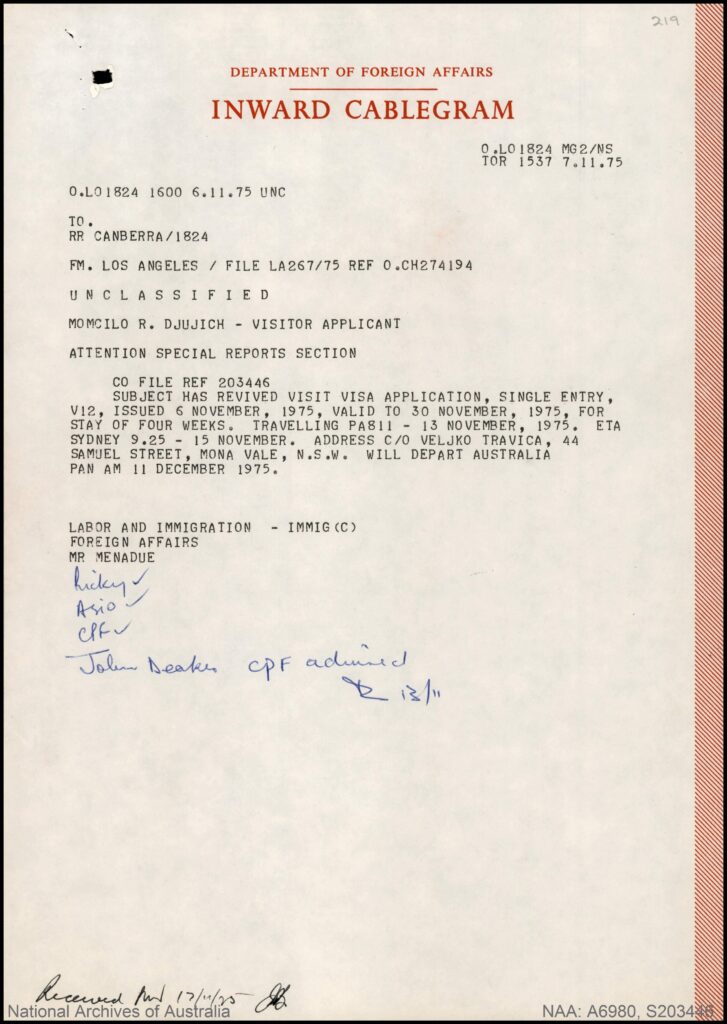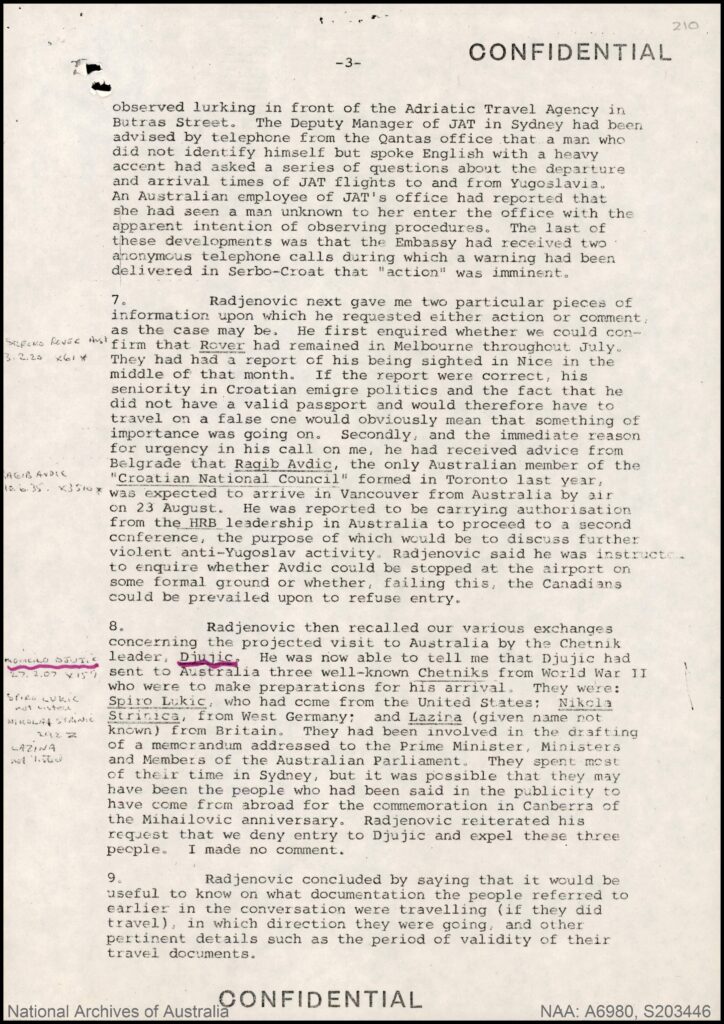
Tantalising new clues to 1975 Whitlam Australian Federal government dismissal
By Sasha Uzunov
Legendary Australian investigative reporter John Pilger and dissident ex United States intelligence officers from the Central Intelligence Agency (CIA) have written extensively about the role of the United States in removing the Whitlam Labor government in Australia in 1975 because of its perceived anti American foreign policy stance. But some tantalising new clues discovered–relating to Whitlam’s relationship with Communist Yugoslavia and its leader Marshal Tito–add to this body of evidence as well as pinpointing the time frame of when the US either made the decision to take down Whitlam or knew Whitlam would be removed.
For the record, on Remembrance Day, November 11, 1975 Australia’s Governor General Sir John Kerr sacked Gough Whitlam as Australia’s Prime Minister after a long political impasse brought upon by the conservative opposition. Whitlam was elected in 1972 as the US war in Vietnam War ended in eventuall defeat for the US and heralded a new era of US uncertainty as a superpower.
The US government hated Whitlam. Let’s be brutally honest here. It hated him because of a perception that the Australian Prime Minister and his political party, the Australian Labor Party (ALP) were anti American and wanted to remove sensitive US spy bases, including Pine Gap and ditch the US and Australian defence alliance known as ANZUS.
That Whitlam reassured the US that he was not anti American but that did not wash with the sceptical Americans, such as US President Richard Nixon, US Secretary of State Henry Kissinger and US Defense Secretary James Schlesinger.
In one infamous exchange between Kissinger and Schlesinger in 1973, Kissinger called Whitlam a bastard.
In 1974 the CIA Director William Colby wrote a paper on a number of hypotheticals relating to Whitlam. He mentioned the possibility of the Whitlam government falling before its term was up in 1977. It had won re-election in 1974.
Whitlam began a romantic political flirtation with Communist Yugoslavia and its ruler Marshal Josip Broz Tito, much to the chagrin of fiercely anti communist Croats and Serbs who had fled the communist state post WWII. Whitlam’s reasoning was he wanted to sound out the Yugoslavs about getting involved with the Non Aligned Movement, an international organisation not tied to the Capitalist West nor Communist East and consisting of “developing” countries of Asia, Africa and of course Yugoslavia.
Tito’s Yugoslavia was tolerated by the West, namely the US, because as a communist state it had broken with the USSR in 1948 as the Cold War began. But Australia aligning itself with Yugoslavia would not have sat well with Washington despite Tito being a de facto US ally. The US-Yugoslav axis was more political expediency than political conviction.
Whitlam also angered Balts- Lithuanians, Latvians and Estonians for in effect recognising the Soviet annexation of the three Baltic States-Lithuanian, Latvia and Estonia.
In 1973 he invited the Yugoslav Prime Minister Dzemal Bjedic to Australia. Enormous controversy was generated by this visit with claims that Croatian natioanlists or terrorists would assassinate the Yugoslav leader. This did not eventuate but using this fear as cover, Whitlam’s Attorney General, Lionel Murphy, led a controversial raid on the head quarters of Australia’s domestic intelligence service (ASIO) wanting to see files on alleged Croat terrorists.
A 1972 incursion wanting into Yugoslavia by a group of 19 Croats, mainly from Australia, added to the already existing tension.
Whitlam’s Deputy Prime Minister, Jim Cairns, a man of the hard left, was seen by Washington as leading a powerful faction within the government which wanted to kick out the US military bases.
On 10 January 1975 Prime Minister Whitlam made an official state visit to Yugoslavia. The New York Times reported:
Australia’s Prime Minister, Gough Whitlam, said tonight that he had asked Yugoslav leaders to sponsor at least observer status for Australia at future meetings of nonaligned nations.
Mr. Whitlam said that his country “is not a nonaligned nation, but that many of its positions coincided with those of the so‐called nonaligned bloc. The Australian leader met reporters following meetings with President Tito, Premier Dzemal Bijedic, and other Yugoslav officials.
He said in response to questions that he saw no possibility of conflict between Australia’s proximity to the nonaligned bloc and her membership in the Australia‐New Zealand‐United States pact.

HOT ON THE HEELS
Hot on the heels of this January 1975 Whitlam-Tito meeting in Belgrade, the Yugoslav capital, there was growing speculation that the Yugoslav communist ruler would return the compliment and visit Australia, thereby strengthening Whitlam’s link to the Non Aligned Movement. This would have alarmed the US. The tenure of US spy base Pine Gap in the central Australian desert was up for renewal in December 1975.
Pine Gap was very important to Washington. The installation was able to monitor Soviet communications and nuclear testing activity in the Asia Pacific region. It would make sense that any purported visit by Yugoslav communist ruler Marshal Tito be thwarted without US fingerprints all over the operation. Tito was still an important US ally against Moscow. And the US had just the man for the job. Momcilo Djujic, the US based leader of the fiercely anti communist Serb nationalist movement, called the Chetniks.
He was a long standing US CIA intelligence asset and a Nazi collaborator during WWII who had been rescued by the CIA’s forerunner, the Office of Strategic Services (OSS), and holed up in an Italian Catholic monastery before entering the US in 1949 in what was infamously known as the Vatican Ratlines.
The US Serb Chetnik leader had visited Australia in 1966 despite being an indicted Nazi war criminal wanted by Tito’s Yugoslavia to face trial. Djujic’s 1966 visit was ostensibly to propagandised on behalf of the US government in promoting the then Vietnam War (1962-72) in which Australia was involved alongside the US. Djujic urged Australian Serbs to volunteer for the Australian Army and fight the communists in Vietnam. He had also been on a recruitment tour in the US calling on American Serbs to enlist in the US Army.
Djujic planned to arrive in Australia in May 1975 with the intention of sabotaging any proposed visit by Tito to Australia. The Yugoslav Embassy official in Australia Nikola Radjenovic had got wind of Djujic’s visit through its brutally efficient intelligence service known as the UDBa or SDB. He loudly and bitterly complained to the Australian authorities but to no avail. The Australian government, the Whitlam government, would not be banning Djujic.
Then for reasons unknown, Djujic postponed his trip to Australia till late October 1975. In fact he arrived in November 1975- just after Whitlam had been sacked by the Governor General Sir John Kerr. We can only speculate but a plausible explanation is the CIA decided it did not need its long serving intelligence asset Djujic after all in any anti Whitlam activity as a decision must have been reached in Washington that Whitlam would be removed. So we can take as a time frame that sometime between May and October 1975 that the US either knew or had ordered the removal of Whitlam.
THE DOCUMENTS FROM DJUJIC’S ASIO FILE




